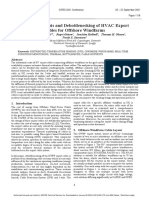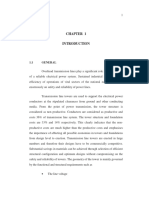Pexlink
Pexlink
Uploaded by
TurnerCopyright:
Available Formats
Pexlink
Pexlink
Uploaded by
TurnerOriginal Description:
Copyright
Available Formats
Share this document
Did you find this document useful?
Is this content inappropriate?
Copyright:
Available Formats
Pexlink
Pexlink
Uploaded by
TurnerCopyright:
Available Formats
PEXLINK
Transmission-line protection for
disturbance-free system operation
1HSA 954321-10en PEXLINK Transmission Line Arresters 1
The PEXLINK concept
Both large & small public & private obtain permission to build new
utility owners of transmission sys- lines of normal dimensions.
tems face a sharpened competitive Hence, new lines under construc-
situation which demands increased tion may mostly be ”compact-insu-
availability and reliability of the lation” lines. This, in turn, requires
systems. Consumers have become optimal control of overvoltages
more demanding as their processes caused by lightning or switching
are dependent on constant and reli- events. Surge arresters installed
able energy supply of good quality. along the line or at a few selected
critical towers, in this case, may be
In many countries, it has also an attractive solution or a comple-
been increasingly difficult to ment to other means.
2 1HSA 954321-10en PEXLINK Transmission Line Arresters
Improvement in the reliability and
availability of a transmission system
can be obtained in one or more of
the following ways:
1. Duplication of the system (more
than one line).
This is a very expensive method and
often impractical.
2. Increased insulation withstand.
It can both be expensive and create
other problems such as the need for
increased insulation of station
equipment.
3. Improved footing impedance.
Often difficult and expensive, specially
in hilly terrain.
4. Shield wires.
If the provision was not in the original
tower design, it can be expensive to
retrofit such shielding. It helps eliminate
a large number of interruptions but it is
not enough to obtain the now-deman-
ded degree of reliability
5. Protection of line insulation by
surge arresters
Surge arresters connected in parallel Picture shows a TLA for 145 kV, comprising
with them at selected towers. In this standard components including PEXLIM arrester
application usually the term line and EXCOUNT-II monitor.
arresters is used.
Protection using polymer-housed arres-
ters (ABB type PEXLIM) along with addi-
tional accessories for fixing the arresters
across the insulators and providing
automatic disconnection of the arresters
in the event of their being overstres-
sed is called the PEXLINK concept.This
method is simple, cost- effective and, in
many cases, an attractive alternative to
the methods mentioned above.
1HSA 954321-10en PEXLINK Transmission Line Arresters 3
ABB´s protection philosophy
ABB’s philosophy is to provide protection for line insulation at selected loca-
tions by using standard available components. The main item is the gapless
silicone polymer-housed arrester, PEXLIM, with metal-oxide (MO) active ele-
ments. Such arresters have been used for many years for protection of equip-
ment in sub-stations and hence their protective performance is well-known.
TLAs, including line discharge class 3 PEXLIM Q arresters and disconnecting devices on earth leads,
erected on ESKOM 300 kV system in South Africa.
The low weight permits installation With regard to lightning energy, line
on existing structures and the polymer arresters are exposed to more severe
housing gives increased safety of the line conditions than arresters placed in
equipment as well as people and animals substations. The latter are benefited
which may be in the vicinity of the lines by the reduction of surge steepness
during overstress conditions. due to line corona effect and reduc-
4 1HSA 954321-10en PEXLINK Transmission Line Arresters
tion in surge amplitude as the light- housing on the active MO elements
ning current finds parallel paths directly, internal atmosphere is elimi-
through shielding wires, flashover nated and with it the risk of ingress
and parallel lines. Thus, it is neces- of moisture which in the past has
sary to ensure that the MO blocks of been established as the major cause
the TLA are not under-dimensioned of arrester failures in service.
from energy and current point-of-
view. A computer program is used
to determine the optimum number
of locations (generally where the
footing impedance is high) and to
calculate the arrester stresses at each
of the chosen locations.
The design permits installation
using standard transmission-line
hardware normally available locally.
The design also permits mounting at
different angles based on tower geo-
metry and conductor spacing.
If very high availability is desired, a
very large number of locations may
have to be protected, mainly due to
the unpredictable nature of lightning.
In such a case it may not be economi-
cally justified to select arresters with
”sufficient energy capability” and
instead a higher failure rate may be Detailed view of TLA
acceptable. erected under twin-
To ensure quick, safe, automatic and conductors.
controlled disconnection of a failed
arrester, ABB uses a special discon-
necting device with a suitable link,
often in the earthing circuit of the
arresters.
The earth lead is designed to
withstand the short-circuit currents
and the disconnecting device is
tested to ensure no false operations.
Thus, at a failure, the tripped line
does not have to be locked-out and
attended to immediately.
By moulding the silicone polymer
1HSA 954321-10en PEXLINK Transmission Line Arresters 5
Applications
Increased line availability 2/3 line length switching surge overvolta-
By locating the PEXLINK on sections ges and thus line insulation requirements
of lines with high footing impedance could be limited without using pre-
towers and one additional low footing- insertion resistors. Arresters used for this
impedance tower at each end of the type of application should be designed for
section, PEXLINK protects existing
shielded and non-shielded lines from
abnormal lightning surges (frequent or
high amplitudes) and reduces the outages.
The reduced outages are beneficial
also indirectly in that sensitive equip-
ment is not damaged and the circuit
breakers overhaul interval can be
increased.Thus, total maintenance costs
are also reduced.
This protection may be used for all
system voltages where the stated abnor-
mal conditions exist. Arresters with
moderate energy capability are often
sufficient. However, the high-current
capability must be large and distribution-
type arresters may not be suitable.
2% overvoltage values (p.u.)
No overvoltage ���
control
�
���
Surge arresters
at line ends �
���
Surge arresters �
at line ends and
two additional ���
locations along
the line �
� �� �� �� �� ���
The diagram shows overvoltages phase-ground generated by three-
phase reclosing of 550 kV, 200 km transmission line with a previous
ground fault. For long EHV lines pre-insertion resistors tradition-
ally are used to limit switching overvoltages. Surge arresters, as a
robust and efficient alternative, could be located at line ends and Transmission line arrester (PEXLIM P), line dis-
along the line at selected points. charge class 4 for 800 kV system.
For long EHV lines, surge arresters usu- high energy capability. Usually a class 2 or
ally are located at line-ends. In addition, by 3 arrester will be sufficient out on the line
locating arresters at one or more points but higher arrester classes may be neces-
along the line e.g. at midpoint or 1/3 and sary at the receiving end of the line.
6 1HSA 954321-10en PEXLINK Transmission Line Arresters
Compact-insulation lines Extended station protection
Arresters placed in parallel with line By locating arresters on towers near a
insulators permit a large degree of com- substation, the risk of backflashovers
pacting of a transmission line with lower near the station is eliminated. This results
right-of-way costs as a result. in reduction of steepness and ampli-
tude of incoming travelling waves, thus
improving the protection performance of
station arresters and eliminating the need
for additional expensive metal-enclosed
arresters even for large GIS.
Substitute for shield wires
In cases where provision of shield wires
is not practical physically or is very
expensive , e.g. very long spans, very
high towers etc., arresters are a good
and economical substitute.
Compact 400 kV tower without overhead shield Arresters located in all phases on each
wire. Insulators protected by TLA in top phase. tower eliminate the need for both shield
wires and good footing impedance and
Line upgrading may be economically justified in cases
The existing insulation level of a line, where the cost of reduction in footing
when suitably protected by arresters, may impedance and the cost of overhead
be upgraded for service at a higher system shield wire are very high.
voltage leading to greater power transfer
without much additional capital cost.
The effect of transmis-
sion line arrester (TLA)
along a line section
with high tower foot-
ing impedance (TFI).
The figure also dem-
Arresters in towers 3 to 7 only onstrates the need
Arresters in all the 9 towers for TLA at the low TFI
Normal line insulation strength (BIL) towers at the ends of
section.
1HSA 954321-10en PEXLINK Transmission Line Arresters 7
PEXLINK features
Standard components the failure of the arrester. Generally, the
The suspension of the arresters is simp- same is placed in the earth circuit of the
lified and standard clamps and similar arrester but depending on the configura-
hardware normally available may be tion, it may be placed at the high-poten-
used for this purpose. This leads to over- tial end of the arrester. Please refer to
all economy for the user. A few examp- the figures mentioned above.
Major features of the The separation of the disconnector
Arrester Line discharge Energy capability
PEXLIM arresters (which type class as per IEC 60099-4 is quick and effective and the method
as per IEC 60099-4 clause 7.5.5
are the main compo- kJ/kV Ur* of connection advised by ABB in each
nent of PEXLINK) are PEXLIM R Class 2 5.5 kJ/kV (Ur)
particular case ensures that neither the
described at length disconnected wire nor the damaged
PEXLIM Q Class 3 7.8 kJ/kV (Ur)
in the Buyers Guide arrester lead to any interference with
PEXLIM P Class 4 12.0 kJ/kV (Ur)
(PTHVP/A 2200) for other live parts.Thus, after a failure, the
*) Ur = rated voltage
arresters and only a brief line can be re-charged without attending
review is given here. les can be seen in the figures for ”Some to it immediately.
erection alternatives” (page 10). The disconnection is easily visible
The disconnecting device is carefully from the ground and thus locating it is
chosen to perform its function only at simple for the maintenance crew.
Earth
terminal
Disconnecting
device
Standard
line
clamp
Clevis Earth cable to
Shunt link tower leg
Disconnecting
device
Line
terminal Weights
Earth cable to
tower leg
Typical line terminal/clamp arrangement Disconnecting device connected Damping weights connected to earth
(and shunt when necessary) to the earth circuit. terminal to minimize swing angle.
8 1HSA 954321-10en PEXLINK Transmission Line Arresters
Easy to install be easily designed for use on various
The PEXLIM arresters are built-up of voltages. They are light and hence easily
optimum-length modules and hence can transported up the towers.
1HSA 954321-10en PEXLINK Transmission Line Arresters 9
Some erection alternatives
Different arrangements showing how easy it is to install the PEXLINK
concept in towers of different design.
Insulator string
Insulator string
Surge Surge
arrester arrester
Earthing
Earthing cable
cable
Disconnecting Disconnecting
device device
Insulator string
Surge
arrester
Insulator
string
Disconnecting
device
Earthing
cable
Surge Disconnecting
arrester device
Insulator string
Surge Disconnecting
arrester device
10 1HSA 954321-10en PEXLINK Transmission Line Arresters
Terminology
Backflashover Shielding
Occurs when lightning strikes the Protection of phase conductors from
tower structure or overhead shield wire. direct lightning strokes; generally, by
The lightning discharge current, flowing means of additional conductor(s) run-
through the tower and tower footing ning on the top of the towers and groun-
impedance, produces potential differen- ded through the tower structures.
ces across the line insulation.
If the line insulation strength is Shielding angle
exceeded, flashover occurs i.e. a backflas- The included angle, usually between 20
hover. Backflashover is most prevalent to 30 degrees, between shield wire and
when tower footing impedance is high. phase conductor.
Compact insulation lines Shielding failure
Transmission lines with reduced clearan- Occurs when lightning strikes a phase
ces between phases and between phase conductor of a line protected by over-
and earth and with lower insulation level head shield wires.
withstand than for normal lines for the
same system voltage. TLA
Transmission Line Arresters.
Coupling factor
is the ratio of included surge voltage on Tower footing impedance
a parallel conductor to that on a struck The impedance seen by a lightning
conductor. This factor is determined surge flowing from the tower base to
from the geometric relationships bet- true ground.The risk for backflashover
ween phase and ground (or protected increases with increasing footing impe-
phase conductors). A value often used dance.
for estimation purposes is 0.25.
Travelling waves
Energy capability Occur when lightning strikes a transmis-
The energy that a surge arrester can sion line span and a high current surge
absorb, in one or more impulses, without is injected on to the struck conductor.
damage and without loss of thermal stabi- The impulse voltage and current
lity. The capability is different for different waves divide and propagate in both
types and duration of impulses. directions from the stroke terminal
at a velocity of approximately 300
Isokeraunic level meters per microsecond with magni-
Number of annual thunderstorm days for tudes determined by the stroke cur-
a given region. rent and line surge impedance.
1HSA 954321-10en PEXLINK Transmission Line Arresters 11
Produktion: PTHVP/MD MF Repro/Tryck: Henningsons Tryckeri Foto: Hasse Eriksson
1HSA 954321-10en Edition 4, 2002-11
NOTE! ABB is working to continuously improve the products. Therefore we
reserve the right to change design, dimensions and data without prior notice.
ABB Power Technology Products AB
High Voltage Products
Surge Arresters
S-771 80 LUDVIKA, Sweden
Tel: +46 (0)240 78 20 00
Telefax: +46 (0)240 179 83
E-mail: arresters.div@se.abb.com
Internet: http://www.abb.com/arrestersonline
12 1HSA 954321-10en PEXLINK Transmission Line Arresters
You might also like
- 145KV HCB GTPDocument3 pages145KV HCB GTPVishnu ShankerNo ratings yet
- Gtacsr GztacsrDocument1 pageGtacsr GztacsrrooneytuNo ratings yet
- Instruction Manual: FOR Underfrequency/Overvoltage Module Models: UFOV 250A & UFOV 260ADocument22 pagesInstruction Manual: FOR Underfrequency/Overvoltage Module Models: UFOV 250A & UFOV 260ATurnerNo ratings yet
- Optimisation of Power Cable Ampacity in Offshore WDocument10 pagesOptimisation of Power Cable Ampacity in Offshore Wahmed fikryNo ratings yet
- FEM Situation - A Thermal Model For Three-Core Armored Submarine CDocument19 pagesFEM Situation - A Thermal Model For Three-Core Armored Submarine CTrường Thịnh PhanNo ratings yet
- Thermal Analysis and Debottlenecking of HVAC Export Cables For Offshore WindfarmsDocument5 pagesThermal Analysis and Debottlenecking of HVAC Export Cables For Offshore WindfarmsAmmar LateefNo ratings yet
- Trans Line LADocument8 pagesTrans Line LAsantoshkumarNo ratings yet
- EE458Document36 pagesEE458ArishaNo ratings yet
- Insulators 101 Panel Final ADocument84 pagesInsulators 101 Panel Final Avbj1991No ratings yet
- Identification of Problems When Using Long High VoDocument8 pagesIdentification of Problems When Using Long High VoMichael KnopNo ratings yet
- Mech Design - Cond-LineSupDocument16 pagesMech Design - Cond-LineSupAreyan HaqueNo ratings yet
- AL59 157 SQMM Transmission Line SpecificationDocument2 pagesAL59 157 SQMM Transmission Line SpecificationMohamed RafiNo ratings yet
- Spec 46311Document2 pagesSpec 46311DI Vlad Peña PrietoNo ratings yet
- ... HVDC Networks For Offshore Wind PowerDocument22 pages... HVDC Networks For Offshore Wind Powerzorlu.elgin100% (1)
- Experience of Specifying and Using Reactors in A Transmission NetworkDocument8 pagesExperience of Specifying and Using Reactors in A Transmission Networkmrjack1No ratings yet
- A Practical Approach For Determining The Grounding Grid PDFDocument6 pagesA Practical Approach For Determining The Grounding Grid PDFOscar ZambranoNo ratings yet
- The Electromagnetic Theory of Coaxial Transmission Lines and Cylindrical ShieldsDocument48 pagesThe Electromagnetic Theory of Coaxial Transmission Lines and Cylindrical ShieldsSjoerd HulshofNo ratings yet
- Communications OPGW Fittings ClosuresDocument20 pagesCommunications OPGW Fittings ClosuresalisolmazNo ratings yet
- Presented By:-Abiresh Mishra 1011019118 ICE-'B' Guided By: - Mr. Abhisek Parida Assistant Professor Department of ICEDocument22 pagesPresented By:-Abiresh Mishra 1011019118 ICE-'B' Guided By: - Mr. Abhisek Parida Assistant Professor Department of ICEKaran Singhania100% (1)
- MetroDocument36 pagesMetroBhuvanes WaranNo ratings yet
- IS 16227 (Part 2) : 2016 IEC 61869-2: 2012Document1 pageIS 16227 (Part 2) : 2016 IEC 61869-2: 2012NIKUNJ KUMARNo ratings yet
- SO - OP - 3715 - Power System Security GuidelinesDocument47 pagesSO - OP - 3715 - Power System Security GuidelinesRajendra ShresthaNo ratings yet
- Vibration Study - Electromontaj - 400kV Tantareni-Kozlodui - ACSR 160 - 95-Rev. ADocument14 pagesVibration Study - Electromontaj - 400kV Tantareni-Kozlodui - ACSR 160 - 95-Rev. ALiciu Ciprian100% (1)
- DC Distribution Board Specification - Rev2.0Document3 pagesDC Distribution Board Specification - Rev2.0unitedtelNo ratings yet
- Module 4: Substation Equipment's Details and Operations: July 2021Document14 pagesModule 4: Substation Equipment's Details and Operations: July 2021Gundeboyina GopiNo ratings yet
- The World's Most Efficient High Capacity Transmission ConductorDocument2 pagesThe World's Most Efficient High Capacity Transmission ConductorPlanning EngineeringNo ratings yet
- Nexans - Olivier AngoulevantDocument30 pagesNexans - Olivier AngoulevanttomkhaiNo ratings yet
- Transformer Frequency Response AnalysisDocument4 pagesTransformer Frequency Response AnalysisAnonymous OCDJg17ZNo ratings yet
- Gas Insulated Substation (Gis) Vs Conventional Outdoor Substation (Ais)Document12 pagesGas Insulated Substation (Gis) Vs Conventional Outdoor Substation (Ais)Sa'dun ArifNo ratings yet
- Electric Distribution LinesDocument7 pagesElectric Distribution LinesluisepasNo ratings yet
- 8DN8 GIS - CatalogueDocument19 pages8DN8 GIS - CatalogueWayne ChenNo ratings yet
- 15-TMSS-05 R.1Document20 pages15-TMSS-05 R.1wastazoheb_700349353No ratings yet
- 23.0 EHV XLPE Cable Rev01Document23 pages23.0 EHV XLPE Cable Rev01Ashish bhattNo ratings yet
- Investigation Into Transient SFO FFO VFTDocument7 pagesInvestigation Into Transient SFO FFO VFTJosNo ratings yet
- 04 Specification of LA 400 220 132 and 66kV Polymer Housed LA R1 Sept 19Document26 pages04 Specification of LA 400 220 132 and 66kV Polymer Housed LA R1 Sept 19hrcl1104No ratings yet
- In S Coords Ample CalcDocument36 pagesIn S Coords Ample CalcPankaj ThataiNo ratings yet
- Requirements Transmission SystemDocument20 pagesRequirements Transmission Systemgerrzen64No ratings yet
- Siemens Interview QuestionsDocument1 pageSiemens Interview QuestionsAnupam0103No ratings yet
- Acss TWDocument5 pagesAcss TWharoldc4No ratings yet
- 6-Lines and CablesDocument54 pages6-Lines and CablesCaribNo ratings yet
- Grund - Et - Al. 2019 Jicable Proceedings C3 6 Integral Sensing of HV Cable JointsDocument6 pagesGrund - Et - Al. 2019 Jicable Proceedings C3 6 Integral Sensing of HV Cable Jointsatif_aman123No ratings yet
- Cable Ampacity Calculations - A Comparison of Methods PDFDocument7 pagesCable Ampacity Calculations - A Comparison of Methods PDFRogelio RevettiNo ratings yet
- Cable With Standing CurvesDocument63 pagesCable With Standing CurvesRatheesh R NairNo ratings yet
- Transpowr Aaac Bare Overhead Conductor: Aluminum Alloy Conductor Concentric-Lay-StrandedDocument3 pagesTranspowr Aaac Bare Overhead Conductor: Aluminum Alloy Conductor Concentric-Lay-Strandedgari_monsantoNo ratings yet
- RE - 5 - Three-Phase Non-Directional Overcurrent Protection Low-Set Stage (NOC3Low) High-Set Stage (NOC3High) Instantaneous Stage (NOC3Inst)Document25 pagesRE - 5 - Three-Phase Non-Directional Overcurrent Protection Low-Set Stage (NOC3Low) High-Set Stage (NOC3High) Instantaneous Stage (NOC3Inst)rajesh100% (1)
- Conductor GallopingDocument21 pagesConductor GallopingRoberto sava100% (2)
- Electric Power TransmissionDocument42 pagesElectric Power TransmissionEarl Jay UayanNo ratings yet
- Interview QuestionsDocument4 pagesInterview QuestionsSandeep Kumar SinghNo ratings yet
- HVDC Rihand 500KVDocument6 pagesHVDC Rihand 500KVpremredNo ratings yet
- Surge Impedance LoadingDocument3 pagesSurge Impedance LoadingMohd Afzal Biyabani100% (1)
- Cigre B2 - 111 - 2008Document10 pagesCigre B2 - 111 - 2008Jorge Pinto RochaNo ratings yet
- EDS-50-05 132-400 KV AC Stations - Standard Reactor SizesDocument5 pagesEDS-50-05 132-400 KV AC Stations - Standard Reactor Sizesraghavendran raghuNo ratings yet
- ELECTABTech81025rHVDrAP - Protection of Transmission Lines Lecture-6 PDFDocument5 pagesELECTABTech81025rHVDrAP - Protection of Transmission Lines Lecture-6 PDFANUJNo ratings yet
- 06 Chapter1 PDFDocument13 pages06 Chapter1 PDFAmritanshu SrivastavaNo ratings yet
- Prospects of Bulk Power EHV and UHV Transmission (PDFDrive)Document20 pagesProspects of Bulk Power EHV and UHV Transmission (PDFDrive)Prashant Trivedi100% (1)
- Earthmat DesignDocument14 pagesEarthmat DesignShanmugam SailappanNo ratings yet
- EPRI High Voltage LaboratoryDocument2 pagesEPRI High Voltage LaboratoryMerlo Llanos Cristian AlvaroNo ratings yet
- Modeling of Photovoltaic Systems Using MATLAB: Simplified Green CodesFrom EverandModeling of Photovoltaic Systems Using MATLAB: Simplified Green CodesNo ratings yet
- Transmission Lines in Digital and Analog Electronic Systems: Signal Integrity and CrosstalkFrom EverandTransmission Lines in Digital and Analog Electronic Systems: Signal Integrity and CrosstalkNo ratings yet
- 9001en Silicone Rubber in OutdoorDocument4 pages9001en Silicone Rubber in OutdoorTurnerNo ratings yet
- 2281en Excount-II Edition 1, 2001-11Document6 pages2281en Excount-II Edition 1, 2001-11TurnerNo ratings yet
- 2100en Surge Arrester Product Programme (English)Document16 pages2100en Surge Arrester Product Programme (English)TurnerNo ratings yet
- 2200en All Sections - Edition 2-2, 2002-09Document72 pages2200en All Sections - Edition 2-2, 2002-09TurnerNo ratings yet
- 2021 Tiguan BuyerGuideDocument4 pages2021 Tiguan BuyerGuideTurnerNo ratings yet
- Can VW My21 WM Allmodel 5na012722gd enDocument38 pagesCan VW My21 WM Allmodel 5na012722gd enTurnerNo ratings yet
- 1SBH143001R8753 Nl53e 125 V DCDocument4 pages1SBH143001R8753 Nl53e 125 V DCTurnerNo ratings yet
- MasterPact NT 47210 Product DatasheetDocument2 pagesMasterPact NT 47210 Product DatasheetTurnerNo ratings yet
- Basler DECS-400 Instruction ManualDocument227 pagesBasler DECS-400 Instruction ManualTurnerNo ratings yet
- BRUSH A12 Data Sheet - 10 - 20Document2 pagesBRUSH A12 Data Sheet - 10 - 20TurnerNo ratings yet
- BRUSH A3100 Data Sheet - 10 - 20Document2 pagesBRUSH A3100 Data Sheet - 10 - 20TurnerNo ratings yet






































































